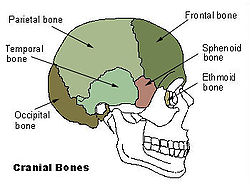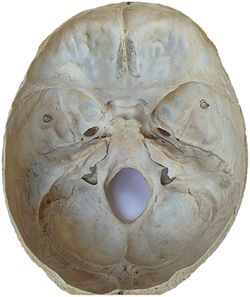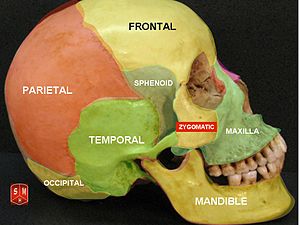- Neurocranium
-
Neurocranium 
Neurocranium (note: diagram uses the term "cranial bones" in the more narrow sense.) 
Base of skull Gray's subject #30 128 In mammals, the neurocranium or braincase is the back part of the skull and houses the brain. In front of it is the interorbital region. The size of the braincase is variable among mammals. The roof may contain ridges such as the temporal crests. Below the braincase is a complex of foramina (openings) and bones, including the foramen magnum which houses the neural spine. The auditory bullae, located in the same region, aid in hearing.[1] In humans, it is the upper portion of the skull.
The neurocranium is formed by the endocranium, the lower portions of the cranial vault, and the skull roof. These are not fused in fishes, and a proper neurocranium is only found in land vertebrates.
In humans, it includes the following bones:
The term "cranium" can be ambiguous, in that it can refer to the neurocranium, or the neurocranium and the Facial skeleton.
Embryonic origins
The neurocranium arises from paraxial mesoderm. There is also some contribution of ectomesenchyme. In Chondrichthyes and other cartilaginous vertebrates this portion of the cranium does not ossify; it is not replaced via endochondral ossification.
See also
References
- ^ Elbroch, M. 2006. Animal skulls: A guide to North American species. Stackpole Books, pp. 20–22. ISBN 9780811733090
Bones of head and neck: compound structures of skull (TA A02.1.00.002–052, GA 2.178–199) Neurocranium Asterion · Pterion · Stephanion · Bregma · Lambda
Fossae: anterior cranial fossa · middle cranial fossa · posterior cranial fossa · cranial cavity
Base of skull
Fontanelles: anterior · posterior · sphenoidal · mastoidFacial skeleton Nasion · GonionBoth Categories:- Skull
- Bones of the head and neck
- Musculoskeletal system stubs
Wikimedia Foundation. 2010.

